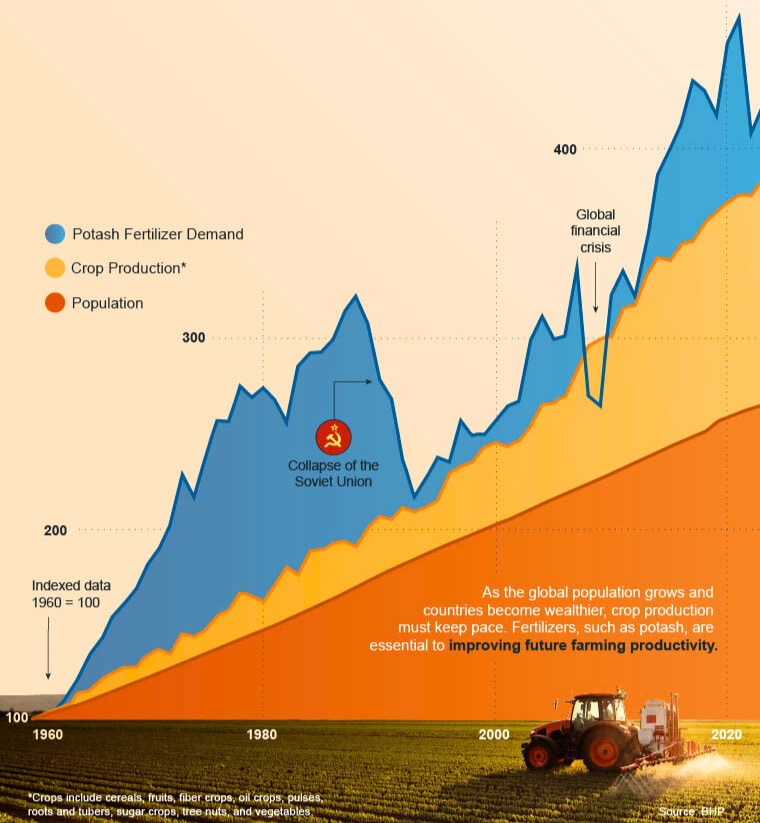09 April 2025
| 2 minute read |
Summary
|
Potash is a crucial component in fertilisers used to enhance crop yields and maintain soil fertility. |
|
|
Population growth and increased crop production has fuelled demand for potash since the 1960s. |
|
|
With the global population expected to reach 9.7 billion by 2050, the need for potash is projected to increase by around 70%. |
Even as the world’s population surged past 8 billion this decade, crop production increased even faster to meet the demand, driven by fertilisers like potash.
What is Potash?
Potash, specifically Muriate of Potash, is a potassium-rich salt used to improve agricultural production. Potassium is essential for plant health as it increases yields, improves water efficiency and improves pest and disease resistance.
Why is potash needed?
Potassium naturally occurs in soil, but farming depletes this mineral faster than naturally occurring sources can replenish it. Regular use of potash helps maintain the productivity of fields that have lost nutrients from years of repeated nutrient removal through harvest.
Population Growth, Crop Production, and Fertiliser Use Since 1960
Since 1960, the world’s demand for crops has skyrocketed, fuelled by a booming population that now exceeds eight billion, rising incomes, and expanding uses for agricultural products.
This line graph charts the trends of population growth, crop production, and potash fertiliser use over six decades.

Six Decades of Growth
The relationship between population growth, crop production, and fertiliser demand is closely interconnected. The growth rate of these three variables, however, has not been equal.
Our analysis reveals that potash demand has significantly outpaced both crop production and population growth since 1960, highlighting its essential role in feeding a growing global population.
| Metric | CAGR | CAGR (2008-2023) |
| Population | 1.7% | 1.1% |
| Crop production | 2.2% | 1.7% |
| Potash fertiliser demand | 2.6% | 3.0% |
*Compound annual growth rate (CAGR) is the average rate at which a value grows annually over a specified period.
The data reveals that despite significant supply disruptions, including the collapse of the Soviet Union - a major potash-producing region - and the 2008 financial crisis, the average annual growth rate of potash demand has consistently surpassed both population growth and crop production.
The Future of Modern Agriculture
By 2050, the global population is expected to reach 9.7 billion, presenting significant challenges in meeting the world’s growing food demands. Farmers are expected to face mounting pressure to produce more food on increasingly limited arable land, making innovation and sustainable practices essential to maximising yields.
Potash - a potassium-rich mineral used to enhance soil fertility and improve crop yields - will play a pivotal role in addressing these challenges.
In fact, we expect global demand for potash to grow by around 70% by 2050, driven by global megatrends such as rising population, improving living standards and changing diets and the need to improve productivity of existing land.
Read more on our commodity insights in BHP’s Economic and Commodity Outlook.
This article was originally published by the Visual Capitalist.
Get the latest BHP news alerts, straight to your inbox
Get BHP news first. Stay in touch with our latest updates, investor news and media releases.



